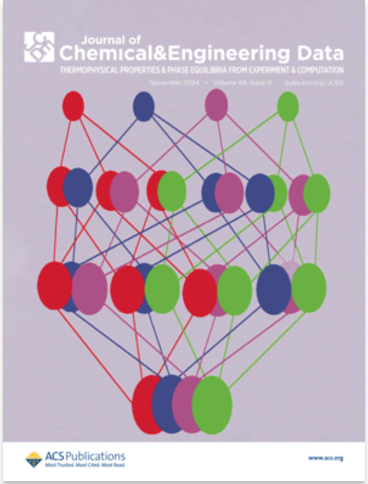皮下注射阿米万他单抗与静脉注射阿米万他单抗联合拉唑替尼治疗难治性表皮生长因子受体突变晚期非小细胞肺癌(NSCLC):全球性三期随机对照 PALOMA-3 试验的主要结果,包括总生存期 (OS)。
IF 2.1
3区 工程技术
Q3 CHEMISTRY, MULTIDISCIPLINARY
Journal of Chemical & Engineering Data
Pub Date : 2024-06-10
DOI:10.1200/jco.2024.42.17_suppl.lba8505
引用次数: 0
摘要
LBA8505 背景:阿米万他单抗(ami)加拉唑替尼(laz)对表皮生长因子受体(EGFR)突变的晚期NSCLC具有抗肿瘤活性。阿米单抗皮下注射(SC)用时≤7分钟,输注相关反应(IRR)发生率低。PALOMA-3(NCT05388669)评估了皮下注射ami+laz与静脉注射ami+laz对EGFR Ex19del或L858R突变晚期NSCLC患者的药代动力学(PK)、疗效和安全性。研究方法头4周每周手动注射1600毫克(2240毫克,体重≥80千克)的阿米,然后每2周注射一次;静脉注射阿米的批准剂量为1050毫克(1400毫克,体重≥80千克)。拉兹的口服剂量为每天240毫克。共同主要PK非劣效性终点是谷浓度(周期[C] 2天[D] 1或C4D1的谷浓度)和C2曲线下面积(AUCD1-D15)。主要次要终点是客观反应率(ORR;非劣效)和无进展生存期(PFS)。OS是预先确定的探索性终点。建议在治疗的前 4 个月进行预防性抗凝治疗。研究结果共有 418 名患者(pts)接受了随机治疗(SC,n = 206;IV,n = 212);416 人接受了≥1 个剂量的治疗。总体而言,中位年龄为 61 岁,67% 为女性,61% 为亚洲人,中位曾接受过 2 次治疗。在中位随访 7.0 个月时,PALOMA-3 达到了两个共同主要终点。C2D1和C4D1的几何平均比(GMRs)分别为1.15(90% CI,1.04-1.26)和1.43(90% CI,1.27-1.61)。C2 AUCD1-D15 的 GMR 为 1.03(90% CI,0.98-1.09)。SC组的ORR为30.1%(95% CI,24-37),IV组为32.5%(95% CI,26-39)(相对风险为0.92;P= 0.001),符合非劣效性标准。阿米+拉兹(SC)与静脉注射的中位应答持续时间(DoR)更长(在确诊应答者中,中位数为11.2个月对8.3个月)。与静脉注射相比,SC 阿米+拉兹的 PFS 呈良好趋势(中位 6.1 个月 vs 4.3 个月;HR,0.84;P= 0.20)。SC ami+laz 与 IV 相比,OS 明显更长(HR,0.62;95% CI,0.42-0.92;名义 P=0.017)。在 12 个月时,65% 的患者存活于 SC 组,而 51% 的患者存活于 IV 组。SC治疗组的IRR比IV治疗组低约5倍:13%比66%,主要是1-2级(分别为0.5%比4%≥3级)。总体而言,81%的患者接受了预防性抗凝药物治疗,其中静脉注射组VTE发生率为9%,而静脉注射组为14%。在两组中,接受预防性抗凝药物治疗的患者 VTE 发生率为 10%,而未接受预防性抗凝药物治疗的患者 VTE 发生率为 21%。在所有接受抗凝药物治疗的患者中,严重出血风险较低(1%≥3 级)。结论:与静脉注射相比,静脉注射阿米的PK和ORR均无劣势。出乎意料的是,与静脉注射相比,静脉注射组的DoR、PFS和OS更长,这表明给药途径或制剂可能会影响疗效。SC 阿米妥英的安全性有所提高,IRR 和 VTE 发生率更低。预防性抗凝可以安全实施并降低 VTE 风险。临床试验信息:NCT05388669 .本文章由计算机程序翻译,如有差异,请以英文原文为准。
Subcutaneous amivantamab vs intravenous amivantamab, both in combination with lazertinib, in refractory EGFR-mutated, advanced non-small cell lung cancer (NSCLC): Primary results, including overall survival (OS), from the global, phase 3, randomized controlled PALOMA-3 trial.
LBA8505 Background: Amivantamab (ami) plus lazertinib (laz) demonstrated antitumor activity in EGFR-mutated advanced NSCLC. Subcutaneous (SC) ami administration takes ≤7 mins and has low infusion-related reaction (IRR) rates. PALOMA-3 (NCT05388669) evaluated SC ami+laz vs IV ami+laz for pharmacokinetics (PK), efficacy, and safety among pts with EGFR Ex19del or L858R-mutated advanced NSCLC and disease progression on osimertinib and platinum-based chemotherapy. Methods: SC ami at 1600 mg (2240 mg, ≥80 kg) was manually injected weekly for the first 4 weeks, then every 2 weeks; IV ami was given at the approved dose of 1050 mg (1400 mg, ≥80 kg). Laz was orally dosed at 240 mg daily. Co-primary PK noninferiority endpoints were trough concentration (Ctrough on Cycle [C] 2 Day [D] 1 or C4D1) and C2 area under the curve (AUCD1-D15). Key secondary endpoints were objective response rate (ORR; noninferior) and progression-free survival (PFS). OS was a predefined exploratory endpoint. Prophylactic anticoagulation was recommended for the first 4 months (mo) of treatment. Results: In total, 418 patients (pts) were randomized (SC, n = 206; IV, n = 212); 416 received ≥1 dose. Overall, median age was 61 years, 67% were female, 61% Asian, and median 2 prior lines. At a median follow-up of 7.0 mo, PALOMA-3 met both co-primary endpoints. Geometric mean ratios (GMRs) comparing SC ami+laz vs IV for Ctrough were 1.15 (90% CI, 1.04–1.26) for C2D1 and 1.43 (90% CI, 1.27–1.61) for C4D1. GMR for C2 AUCD1-D15 was 1.03 (90% CI, 0.98–1.09). ORR was 30.1% (95% CI, 24–37) in the SC arm and 32.5% (95% CI, 26–39) for IV (relative risk, 0.92; P= 0.001), meeting the noninferiority criteria. Median duration of response (DoR) was longer for SC ami+laz vs IV (median, 11.2 vs 8.3 mo among confirmed responders). A favorable PFS trend was observed for SC ami+laz over IV (median, 6.1 vs 4.3 mo; HR, 0.84; P= 0.20). OS was notably longer for SC ami+laz vs IV (HR, 0.62; 95% CI, 0.42–0.92; nominal P= 0.017). At 12 mo, 65% were alive in the SC arm vs 51% for IV. IRRs were ~5-fold lower in the SC arm: 13% vs 66% for IV, primarily grade 1-2 (0.5% vs 4% grade ≥3, respectively). Overall, 81% received prophylactic anticoagulants, with VTE reported by 9% in the SC arm vs 14% for IV. Across both arms, VTE incidence was 10% for pts who received prophylactic anticoagulants vs 21% for pts who did not. Severe bleeding risk was low among all pts receiving anticoagulants (1% grade ≥3). Conclusions: SC ami demonstrated noninferior PK and ORR compared to IV. Unexpectedly, DoR, PFS, and OS were longer in the SC arm vs IV, suggesting that the route of administration or formulation may affect outcomes. The safety profile was improved for SC ami, with lower IRR and VTE rates. Prophylactic anticoagulation can be safely implemented and reduces VTE risk. Clinical trial information: NCT05388669 .
求助全文
通过发布文献求助,成功后即可免费获取论文全文。
去求助
来源期刊

Journal of Chemical & Engineering Data
工程技术-工程:化工
CiteScore
5.20
自引率
19.20%
发文量
324
审稿时长
2.2 months
期刊介绍:
The Journal of Chemical & Engineering Data is a monthly journal devoted to the publication of data obtained from both experiment and computation, which are viewed as complementary. It is the only American Chemical Society journal primarily concerned with articles containing data on the phase behavior and the physical, thermodynamic, and transport properties of well-defined materials, including complex mixtures of known compositions. While environmental and biological samples are of interest, their compositions must be known and reproducible. As a result, adsorption on natural product materials does not generally fit within the scope of Journal of Chemical & Engineering Data.
 求助内容:
求助内容: 应助结果提醒方式:
应助结果提醒方式:


